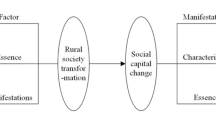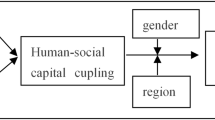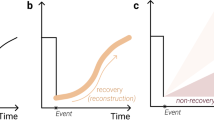Abstract
Human and social capital help households cope with disastrous shocks. We analyse panel survey data from before and after the 2015 Nepal earthquakes to disentangle the association between post-earthquake income recovery of households and their social and human capital before the earthquake. Our analysis uses multidimensional measures of human and social capital and a machine-learning algorithm, the Bayesian additive regression tree. This approach helps us address measurement and estimation challenges that commonly affect social science analyses of observational data with many covariates and confounding variables. Our analysis shows the relative association of human capital with income recovery is greater on average than that of social capital, human and social capital serve as partial substitutes for each other when it comes to household income recovery, and the association of different capitals with economic recovery is nonlinear and heterogeneous across household education levels. Our results suggest that disaster-support policies can be structured with respect to human and social capital endowments to support more effective recovery of disaster-affected households.
This is a preview of subscription content, access via your institution
Access options
Access Nature and 54 other Nature Portfolio journals
Get Nature+, our best-value online-access subscription
$32.99 / 30 days
cancel any time
Subscribe to this journal
Receive 12 digital issues and online access to articles
$119.00 per year
only $9.92 per issue
Buy this article
- Purchase on SpringerLink
- Instant access to full article PDF
Prices may be subject to local taxes which are calculated during checkout



Similar content being viewed by others
Data availability
The data (in comma-separated values/CSV file format) are available in Supplementary Data 1. It includes the dataset for the main analysis. Source data are provided with this paper.
Code availability
The code used for the analysis is available from the corresponding author on reasonable request.
References
Linnerooth-Bayer, J., Mechler, R. & Pflug, G. Refocusing disaster aid. Science 309, 1044–1046 (2005).
Sakai, Y., Estudillo, J. P., Fuwa, N., Higuchi, Y. & Sawada, Y. Do natural disasters affect the poor disproportionately? Price change and welfare impact in the aftermath of typhoon Milenyo in the rural Philippines. World Dev. 94, 16–26 (2017).
Jodha, N. S. Common property resources and rural poor in dry regions of India. Econ. Polit. Wkly 21, 1169–1181 (1986).
Agrawal, A., McSweeney, C. & Perrin, N. Local Institutions and Climate Change Adaptation (World Bank, 2008); https://openknowledge.worldbank.org/handle/10986/11145
Speranza, C., Wiesmann, U. & Rist, S. An indicator framework for assessing livelihood resilience in the context of social–ecological dynamics. Glob. Environ. Change 28, 109–119 (2014).
Acemoglu, D., Gallego, F. A. & Robinson, J. A. Institutions, human capital, and development. Annu. Rev. Econ. 6, 875–912 (2014).
Bourdieu, P. & Richardson, J. G. Handbook of Theory and Research for the Sociology of Education (Greenwood Press, 1986).
Coleman, J. S. Social capital in the creation of human capital. Am. J. Sociol. 94, S95–S120 (1988).
Aldrich, D. P. Building Resilience: Social Capital in Post-Disaster Recovery (Univ. Chicago Press, 2012).
Zahnow, R., Wickes, R., Taylor, M. & Corcoran, J. Community social capital and individual functioning in the post-disaster context. Disasters 43, 261–288 (2019).
Nakagawa, Y. & Shaw, R. Social capital: a missing link to disaster recovery. Int. J. Mass Emerg. Disasters 22, 5–34 (2004).
Muttarak, R. & Lutz, W. Is education a key to reducing vulnerability to natural disasters and hence unavoidable climate change? Ecol. Soc. 19, 42 (2014).
Balgah, R. A., Bang, H. N. & Fondo, S. A. Drivers for coping with flood hazards: beyond the analysis of single cases. Jamba 11, 678 (2019).
Santarelli, E. & Tran, H. T. The interplay of human and social capital in shaping entrepreneurial performance: the case of Vietnam. Small Bus. Econ. 40, 435–458 (2013).
Meier, K. J., Favero, N. & Compton, M. Social context, management, and organizational performance: when human capital and social capital serve as substitutes. Public Manage. Rev. 18, 258–277 (2016).
Chipman, H. A., George, E. I. & McCulloch, R. E. BART: Bayesian additive regression trees. Ann. Appl. Stat. 4, 266–298 (2010).
Hill, J. L. Bayesian nonparametric modeling for causal inference. J. Comput. Graph. Stat. 20, 217–240 (2011).
Cabras, S., Horrillo, T. & de Dios, J. A Bayesian Model to Estimate Causality in PISA Scores: A Tutorial with Application to ICT (UC3M, 2015); https://e-archivo.uc3m.es/handle/10016/21456
Nepal Earthquake 2015: Post Disaster Needs Assessment Vol. B (National Planning Commission, 2015); https://www.npc.gov.np/images/category/PDNA_volume_BFinalVersion.pdf
Schultz, T. W. Investment in human capital. Am. Econ. Rev. 51, 1–17 (1961).
Dagum, C. & Slottje, D. J. A new method to estimate the level and distribution of household human capital with application. Struct. Change Econ. Dyn. 11, 67–94 (2000).
Lopez, J. H., Fajnzylber, P. & Acosta, P. The Impact of Remittances on Poverty and Human Capital: Evidence from Latin American Household Surveys (World Bank, 2007); https://doi.org/10.1596/1813-9450-4247
Vemuri, A. W. & Costanza, R. The role of human, social, built, and natural capital in explaining life satisfaction at the country level: toward a national well-being index (NWI). Ecol. Econ. 58, 119–133 (2006).
Woolcock, M. & Narayan, D. Social capital: implications for development theory, research, and policy. World Bank Res. Obs. 15, 225–249 (2000).
Lin, N. Social Capital: A Theory of Social Structure and Action (Cambridge Univ. Press, 2002).
Flap, H. & Völker, B. Creation and Returns of Social Capital (Routledge, 2004).
Coleman, J. S. Foundations of Social Theory (Harvard Univ. Press, 1994).
Portes, A. Social capital: its origins and applications in modern sociology. Annu. Rev. Sociol. 24, 1–24 (1998).
Maluccio, J., Haddad, L. & May, J. Social capital and household welfare in South Africa, 1993–98. J. Dev. Stud. 36, 54–81 (2000).
Islam, A. & Nguyen, C. Do networks matter after a natural disaster? A study of resource sharing within an informal network after cyclone Aila. J. Environ. Econ. Manage. 90, 249–268 (2018).
Borgatti, S. P., Jones, C. & Everett, M. G. Network measures of social capital. Connections 21, 27–36 (1998).
Mulder, K., Costanza, R. & Erickson, J. The contribution of built, human, social and natural capital to quality of life in intentional and unintentional communities. Ecol. Econ. 59, 13–23 (2006).
Mathbor, G. M. Enhancement of community preparedness for natural disasters: the role of social work in building social capital for sustainable disaster relief and management. Int. Soc. Work 50, 357–369 (2007).
Narayan, D. & Pritchett, L. Cents and sociability: household income and social capital in rural Tanzania. Econ. Dev. Cult. Change 47, 871–897 (1999).
Islam, R. & Walkerden, G. How bonding and bridging networks contribute to disaster resilience and recovery on the Bangladeshi coast. Int. J. Disaster Risk Reduct. 10, 281–291 (2014).
Nguyen-Trung, K., Forbes-Mewett, H. & Arunachalam, D. Social support from bonding and bridging relationships in disaster recovery: findings from a slow-onset disaster. Int. J. Disaster Risk Reduct. 46, 101501 (2020).
Burt, R. S. The network structure of social capital. Res. Organ. Behav. 22, 345–423 (2000).
Gignoux, J. & Menéndez, M. Benefit in the wake of disaster: long-run effects of earthquakes on welfare in rural Indonesia. J. Dev. Econ. 118, 26–44 (2016).
MacGillivray, B. H. Beyond social capital: the norms, belief systems, and agency embedded in social networks shape resilience to climatic and geophysical hazards. Environ. Sci. Policy 89, 116–125 (2018).
Marín, A., Bodin, Ö., Gelcich, S. & Crona, B. Social capital in post-disaster recovery trajectories: insights from a longitudinal study of tsunami-impacted small-scale fisher organizations in Chile. Glob. Environ. Change 35, 450–462 (2015).
Cutter, S. L., Burton, C. G. & Emrich, C. T. Disaster resilience indicators for benchmarking baseline conditions. J. Homel. Secur. Emerg. Manage. 7, 1–22 (2010).
Shimada, G. The role of social capital after disasters: an empirical study of Japan based on time-series-cross-section (TSCS) data from 1981 to 2012. Int. J. Disaster Risk Reduct. 14, 388–394 (2015).
Paudel, J. & Ryu, H. Natural disasters and human capital: the case of Nepal’s earthquake. World Dev. 111, 1–12 (2018).
Rayamajhee, V., Storr, V. H. & Bohara, A. K. Social entrepreneurship, co-production, and post-disaster recovery. Disasters https://doi.org/10.1111/disa.12454 (2020).
Ferraro, P. J., Sanchirico, J. N. & Smith, M. D. Causal inference in coupled human and natural systems. Proc. Natl Acad. Sci. USA 116, 5311–5318 (2019).
King, G. & Nielsen, R. Why propensity scores should not be used for matching. Polit. Anal. https://doi.org/10.1017/pan.2019.11 (2019).
Alkire, S. & Foster, J. Understandings and misunderstandings of multidimensional poverty measurement. J. Econ. Inequal. 9, 289–314 (2011).
Alkire, S. & Foster, J. Counting and multidimensional poverty measurement. J. Public Econ. 95, 476–487 (2011).
Morita, S. & Müller, P. Bayesian population finding with biomarkers in a randomized clinical trial. Biometrics 73, 1355–1365 (2017).
Adger, W. N. Social and ecological resilience: are they related? Prog. Hum. Geogr. 24, 347–364 (2000).
Dalu, M. T. B. & Shackleton, C. M. The potential use of natural resources in urban informal settlements as substitutes for financial capital during flooding emergencies. Phys. Chem. Earth. 104, 18–27 (2018).
Choi, J., Deshmukh, A. & Hastak, M. Seven-layer classification of infrastructure to improve community resilience to disasters. J. Infrastruct. Syst. 25, 04019012 (2019).
Godfrey, J., Saliceto, G. & Yegidis, R. Role of public transportation in a natural disaster state of emergency declaration. Transp. Res. Rec. 2673, 230–239 (2019).
Tan, Y. V., Flannagan, C. A. C. & Elliott, M. R. Predicting human-driving behavior to help driverless vehicles drive: random intercept Bayesian additive regression trees. Stat. Interface 11, 557–572 (2018).
Chipman, H. A., George, E. I. & Mcculloch, R. E. in Advances in Neural Information Processing Systems 19 (eds Schölkopf, B. et al.) 265–272 (MIT Press, 2007).
Tan, Y. V. & Roy, J. Bayesian additive regression trees and the general BART model. Stat. Med. 38, 5048–5069 (2019).
Green, D. P. & Kern, H. L. Modeling heterogeneous treatment effects in survey experiments with Bayesian additive regression trees. Public Opin. Q. 76, 491–511 (2012).
Hill, J., Linero, A. & Murray, J. Bayesian additive regression trees: a review and look forward. Annu. Rev. Stat. Appl. 7, 251–278 (2020).
Acknowledgements
We acknowledge the support of the National Science Foundation (RAPID: Global Dependence of Livelihoods on Forests and the Impacts of Forest Investments: Disaster Recovery in Nepal (SES-1636754)). We also acknowledge X. Wang for his support on statistical analysis and A. Aekakkararungroj for his support on spatial map generation.
Author information
Authors and Affiliations
Contributions
E.G. and A.A. designed the research and managed data collection. W.L. cleaned and managed the data. W.L. designed the analytical framework and carried out initial and subsequent data analysis. W.L. and S.J. carried out additional data analysis and robustness checks. W.L., A.A., E.G. and S.J. wrote and revised the manuscript.
Corresponding author
Ethics declarations
Competing interests
The authors declare no competing interests.
Additional information
Peer review information Nature Sustainability thanks Beate Volker and the other, anonymous, reviewer(s) for their contribution to the peer review of this work.
Publisher’s note Springer Nature remains neutral with regard to jurisdictional claims in published maps and institutional affiliations.
Supplementary information
Supplementary Information
Supplementary Note 1.
Supplementary Data 1
Dataset for the main analysis.
Source data
Source Data Fig. 2
Source data for Fig. 2.
Source Data Fig. 3
Source data for Fig. 3.
Rights and permissions
About this article
Cite this article
Liu, W., Gerber, E., Jung, S. et al. The role of human and social capital in earthquake recovery in Nepal. Nat Sustain 5, 167–173 (2022). https://doi.org/10.1038/s41893-021-00805-4
Received:
Accepted:
Published:
Issue date:
DOI: https://doi.org/10.1038/s41893-021-00805-4
This article is cited by
-
Social Capital and Hit-and-Run Road Accidents: Evidence from Italy
Italian Economic Journal (2025)
-
Untapped capacity of place-based peer-to-peer resource sharing for community resilience
Nature Cities (2024)
-
A data-driven approach to rapidly estimate recovery potential to go beyond building damage after disasters
Communications Earth & Environment (2023)
-
Disaster recovery via social capital
Nature Sustainability (2021)



